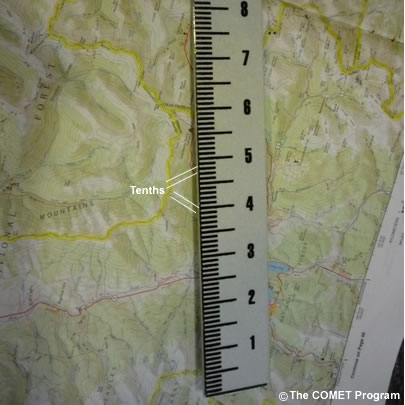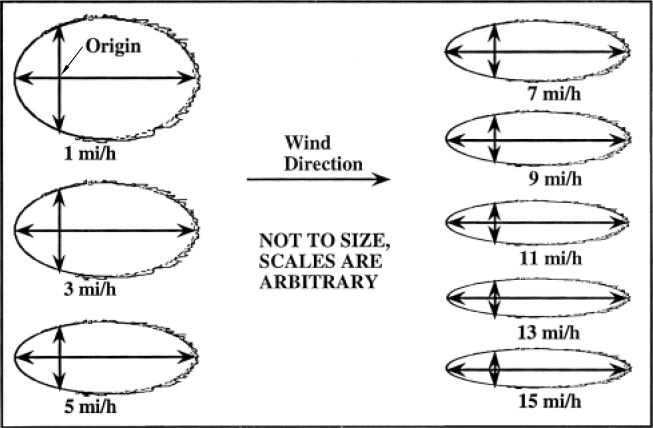5.3 Spread Distance
5.3 Spread Distance Anonymous (not verified)Spread distance (SD) is the forward distance a fire spreads in a given amount of time. SD can be calculated from rate of spread (ROS) and projected time (PT).
Spread Distance = Rate of Spread × Projected Time
SD = ROS × PT
Example 1 - What is the spread distance, in feet, for a fire that has a rate of spread of 6 chains per hour for a 3-hour time span?
Step 1. Use the equation for determining the spread distance.

Step 2. The answer needs to be in feet. Set up the cancellation table so all units will cancel, except the
desired unit, feet.

The spread distance is 1,188 feet.
Example 2 - Using the information in Example 1, find the map distance of the fire spread. The map scale is 1:31,680 (inch/inch).
Step 1. Convert inch/inch to feet/inch. Set up the cancellation table so all units will cancel, except the desired unit, feet/inch.

Step 2. Convert the ground spread distance to a map spread distance.

The map distance is 0.45 inches.
MAP SPREAD WORKSHEET
These values can be summarized in a Map Spread Worksheet.
Map Spread Worksheet (blank version)
| Line | Input | |||
| 0 | PP | Projection point | ______ | ______ |
| 1 | ROS | Rate of spread, ch/h | ______ | ______ |
| 2 | PT | Projection time, h | ______ | ______ |
| 3 | SDCM | Spread distance, ch (line 1 x line 2) | ______ | ______ |
| 4 | SDFT | Spread distance, ft (line 3 x 66 ft/ch) | ______ | ______ |
| 5 | SCL | Map scale | ______ | ______ |
| 6 | CF | Conversion factor, ft/in (see map scale conversion) | ______ | ______ |
| Output | ||||
| 1 | MD | Map spread distance, in (line 4 divided by line 6) | ______ | ______ |
Map Spread Worksheet (completed)
| Line | Input | |||
| 0 | PP | Projection point | A | Given |
| 1 | ROS | Rate of spread, ch/h | 6 | Given |
| 2 | PT | Projection time, h | 3 | From ex. 1 |
| 3 | SDCM | Spread distance, ch (line 1 x line 2) | 18 | From ex. 1 |
| 4 | SDFT | Spread distance, ft (line 3 x 66 ft/ch) | 1188 | From ex. 9 |
| 5 | SCL | Map scale | 1:31,680 | From ex. 2 |
| 6 | CF | Conversion factor, ft/in (see map scale conversion) | 2640 | From ex. 2 |
| Output | ||||
| 1 | MD | Map spread distance, in (line 4 divided by line 6) | .45 | from ex. 2 |
When completing the map spread worksheet, notice that the projection point is line zero. Line 1 begins with the rate of spread.
Fire Area Size Worksheet
| Line | Input | ||
| 0 | PP | Projection point | ______ |
| 1 | ROS | Rate of spread, ch/h | ______ |
| 2 | EWS | Effective windspeed, mi/h | ______ |
| 3 | PT | Projection time, h | ______ |
| 4 | SDF | Spread distance, ch | ______ |
| Output | |||
| PER | Perimeter, ch | ______ | |
| AC | Area, ac | ______ |
Practice Quiz
Select the correct answer(s) from the questions below:
FORWARD RATE OF SPREAD
The shape of a fire is dependent on slope and effective windspeed. The higher the windspeed and slope percent, the longer, more cigar-shaped the burn area.
Click to view animation of slope and wind effects on fire
Safety dictates that firefighters be positioned at the flanks (sides) or back of a fire. A firefighter should never be uphill (at the head) of a fire where the rate of spread is the fastest. See the Standard Fire Orders (F-I-R-E-O-R-D-E-R-S) in the Fireline Handbook, PMS 410-1 or NFES 0065.
USING A SCALED RULER FOR SPREAD MEASUREMENTS
When drawing or measuring distances, a scaled ruler is sometimes necessary for direct measurements. A scaled ruler, or engineer's ruler, has 1-inch increments subdivided into 1/10-inch increments, convenient for ground measurements. Ground measurements are usually given in fractions of multiples of 10. Consider a map distance of 3.7 inches, where 1 inch equals 100 feet. In this case, each tenth of an inch will equal 10 feet. Consequently, 3.7 inches equals 370 feet.

MAP SPREAD WORKSHEET
All data collected and calculated related to spread distance and rate of spread can be put into a map spread worksheet.
Example 3 - Using a ruler scaled in 1/10 inch or 0.1 inch increments, draw a sketch of the burn in Example 2. The effective windspeed is 3 miles/hour. Complete the map spread worksheet. See the steps and illustrations below.
Step 1. Draw a line of 0.5 inches from point A up the slope to point B.
A - B
Step 2. See the fire shapes in the fire shape figure below to determine how wide to make the ellipse.
Step 3. Draw an ellipse around the line drawn.


Fire shape depends on effective windspeeds.
